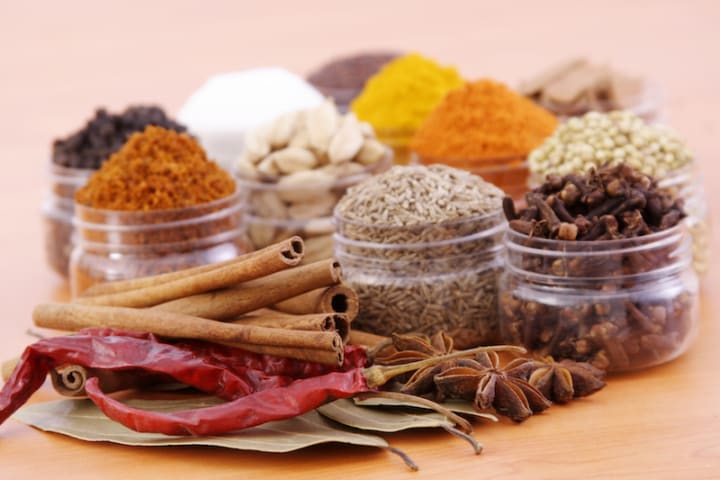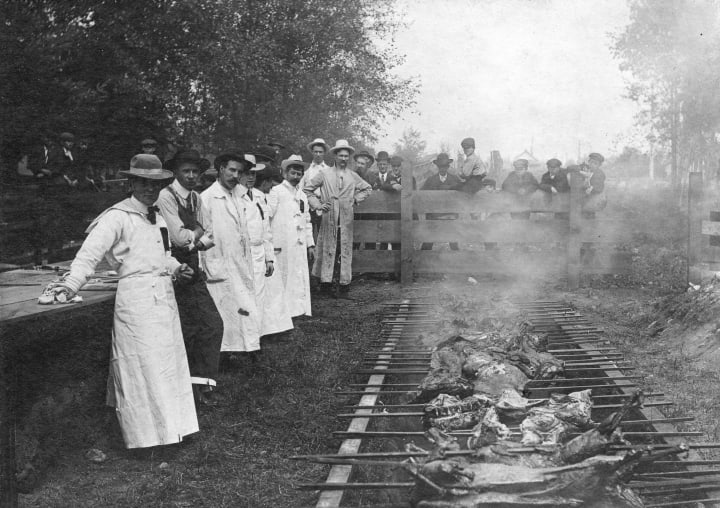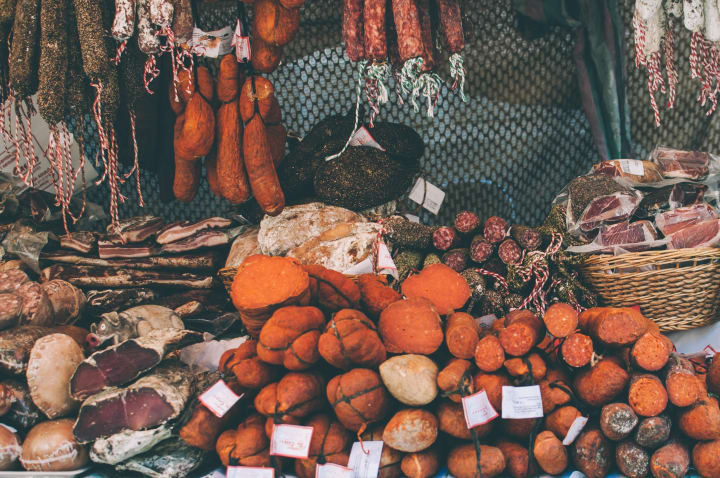
Nice discussion. most of this is still around an organized kitchen. For most though we are using the stew pot for everything because it remains unspoiled.
Meat was rare, but small game and left over bones could be thrown in.
Besides the vegetable pottage, we also have any type of grain porridge as well..both are filling.
Everything else required better tools such as a stove or oven and a skillet of course. Yet a lot could be done even with a rawhide lined boiling pit and hot stones 60,000 years ago.
How People Prepared Food in the Dark Ages
Ever wonder how people prepared food during the Dark Ages? We did, too... and decided to find out.
https://vocal.media/feast/how-people-prepared-food-in-the-dark-ages
Cooking is one of the most human acts that you can perform. The art of cooking is something that has bonded people together, become a part of our cultural identities, and also become part of our history. Though the very basics of cooking never seem to change, the truth is that cooking styles do change over the years.
As a food critic, I tend to associate a lot of traits of a culture with the food they prepare. As an armchair historian, I also get curious about what life was like throughout history. This means that I tend to be very curious about what food tasted like, how people prepared food, and what people considered to be quality cuisine.
Did you ever wonder how people prepared food in the Dark Ages? Or even, what food tasted like back then? I know I did.
In order to find out the truth, I did a little bit of online research. Here's how people prepared food in the Dark Ages, from what historical records have shown.
Ale and Wine

Before we discuss how people prepared food in the Dark Ages, let's talk about how people prepared the drinks du jour.
How people prepared alcoholic beverages in the Dark Ages isn't that much different than how people prepare them now. Beer and ales were brewed with yeast in barrels, while wines were left to ferment in casks.
The only major difference that people would notice is that many wine varietals hadn't really been invented yet. However, there were some varietals you might have recognized — Bordeaux, Champagne, and Burgundy all were famous for their grapes.
That being said, wine often was just wine to people in the Dark Ages. Drinking was banned in many parts of Europe, but monastic vineyards kept the tradition of winemaking and brewing alive.
In fact, people would often mix grapes in order to make wine if a particularly harsh bout of weather harmed crops. Most people who could afford wine or ale mixed it with water since water was often too unclean to actually sip on its own.
Dark Age Sauces

One thing that scientists only recently learned about how people prepared food in the Dark Ages dealt with sauces. Apparently, people who lived back in the Dark Ages were huge fans of sauce — just like we are today.
However, this was prior to the time that the New World was discovered. So, many of the herbs and spices we now use weren't present. According to a manuscript that was only recently discovered, sauces that were used were heavy in coriander, parsley, pepper, sage, garlic, and mustard.
Experts believe that sauce seasonings that were made in the Dark Ages, therefore, had "a Middle Eastern, Lebanese feel" to their recipes. This also proves that there was still trade going on during the Dark Ages — even in Poitou, France!
Fish

If you lived during the Medieval Age or the Dark Ages, fish was most likely what was for dinner. Fishing was an integral part of the economy back then, and everyone from royalty to peasantry ate fish as the meat of choice.
Fish is a Dark Ages food staple. In fact, it was one of only two kinds of meat allowed for regular dinner meals in monastic groups.
You're probably wondering how people got their food in the Dark Ages, when fishing technology was nothing like what it is today.
Believe it or not, people in the Medieval Ages had fisheries and even harvested fish in kiddles. In the 8th century, there were occasions when people used eel nets as a way to get food during a shortage.
Now, let's talk about how people prepared their food during this time. Most commonly, fish was stored using salt, or cured using smoke huts — depending on where you lived.
If you had fresh fish and lived in the Dark Ages, then you could enjoy it with simple seasonings like honey, vinegar, mustard seed, salt, or whatever herbs you were growing in your garden.
Pottage

When most people research how people prepared food back in the Medieval Ages and Dark Ages, they will run across a word they've never seen before: pottage.
Pottage is a now-archaic form of stew that was made to be thick, hearty, and also a known food of peasants and church officials during the time. This stew typically had no meat in it but was filled with whatever vegetables and herbs peasants could find.
Records show that cabbage, turnips, and celery were popular at the time. If a peasant family was wealthy enough, they'd use saffron to add coloring to the soup.
Once water was added to the vegetable mixture, it would cook in a pot over a low open fire for hours. As it cooked the mixture would occasionally get stirred until it turned into a thick soup.
It may not sound like much, but the truth is that a lot of the recipes we use now get their roots from pottage — and that includes slow cooker stews!
Bread

Almost every country had a form of bread that peasants and royals would both enjoy. How people prepared food staples like bread remains fairly similar to today's methods, depending on where you live.
Flours made from wheat, rye, or even barley were commonly used to make bread. White bread was a status symbol, so wheat bread typically belonged to nobility, while rye bread was seen as a peasant's dish.
Sounds similar so far, right?
However, here's where everything becomes very different: rather than just use yeast like we do today, many people just used ale-barm — a mixture of beer and yeast — to make the bread rise. Bread was baked in a fire oven, much like how pizza is done today.
If peasants didn't have enough ale-barm to make regular bread, they would just mix oats with water. Then, they'd bake them with honey or spices. At times, eggs may have been added in, too. These were known as oatcakes, and they were as common as they could be.
Oatcakes may have actually been more common than regular bread at one point in the Dark Ages. In fact, archeologists have actually found records of oatcake kits for travelers who wanted to make their own while they were around.
Unleavened bread also was common among peasants, but we're guessing oatcakes were where it's at.
Pigs, Cows, and Chicken

One of the most elegant ways to prepare rare and expensive meats like pork or chicken was to spit roast the entire animal.
However, this was something that was often only doable for the upper class, since spit roasting required to have a staff person on hand called a turnspit who could turn the spit constantly. Not having someone who could constantly turn the spit meant that the meat would cook unevenly, or even burn.
By the 16th century, technology improved via our canine friends. That's right, people in the Medieval Ages actually used dogs on wheels called turnspit dogs to roast meat. However, that's not quite the Dark Ages, is it?
So, you're probably wondering how people prepared food involving more impressive animals if they couldn't afford a turnspit. Well, the other option was to cut up the meat into more easy-to-prepare slices.
If you were nobility and throwing a banquet, stuffed whole animals were the way to go. Though we still may eat turducken on Christmas or Thanksgiving, this tradition has thankfully given way to more reasonable party dishes.
Many meat cuts we recognize today had their roots in Dark Ages butchering. In fact, one of the earliest historical records of butchering as a skilled trade can be traced back to 975 in London, England.
Even back then, people had discovered that different cuts of meat would taste and feel different in your mouth. As a result, how people prepared food in the Dark Ages depended on the cut of meat used, and what spices were available.
Preserves

By the Dark Ages, there were a number of different ways to preserve goods of every kind. Cured meats, salted meats, and smoked meats were all common — but we've already discussed that.
For vegetables, pickling in a brine-herb seasoning was often the preservation method of choice. Vegetables, fruits, and meats were also dried in a special area of the house in order to keep them preserved for winter.
What you might be shocked to learn about how people prepared food back then was that gelatin was a major preservation method of this time. In fact, it was used as a preservation method for almost every kind of food!
Vegetables, fruit, and meat were all preserved in gelatin. Honey was also used as a sweetener during these times, which in turn made these gelatin preserves a rudimentary form of jam in many cases.
Lastly, fruits, flowers, and nuts could also be candied via dipping in sugar or honey. This allowed them to last through the winter, which in turn probably excused the meat gelatin people had to eat.
No comments:
Post a Comment